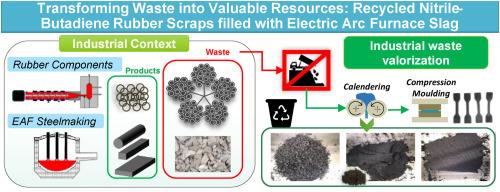Transforming waste into valuable resources: Recycled nitrile-butadiene rubber scraps filled with electric arc furnace slag
IF 5.3
Q2 ENGINEERING, ENVIRONMENTAL
引用次数: 0
Abstract
This study investigates the valorization of two industrial waste streams - nitrile butadiene rubber (NBR) scraps and electric arc furnace (EAF) slag – in the development of recycled NBR compounds filled with EAF slag as filler. A new recycling method for NBR scraps is employed via calendering at room temperature without the need for curatives, chemical agents, or pre-grinding. The resulting recycled NBR is then used as a matrix for EAF slag particles to produce sustainable rubber compounds that are entirely recycled. Characterization reveals that incorporating EAF slag enhances the devulcanization process of recycled NBR during recycling. The filler grain size affects composite properties like hardness, crosslink density, and tensile modulus, with finer slag particles (<50 μm) exhibiting improved reinforcement due to increased interaction surface with the rubber matrix. Dynamic mechanical analysis indicates that recycled NBR filled with EAF slag exhibits a more significant Payne effect compared to unfilled recycled NBR, due to filler-matrix interactions. Interestingly, EAF slag facilitates the rapid fractional recovery of the low-strain storage modulus after experiencing high-amplitude strain, ascribed to the formation of a rigid rubber layer around the slag particles.
Overall, the findings highlight the potential to valorize these two waste materials effectively by producing functional recycled NBR/EAF slag composites with desirable properties through a simple, industrially viable recycling method without capital-intensive equipment. This represents both environmental and economic benefits through waste valorization and industrial symbiosis.

变废为宝回收的丁腈橡胶废料填充电弧炉炉渣
本研究调查了丁腈橡胶(NBR)下脚料和电弧炉(EAF)炉渣这两种工业废料在开发以电弧炉炉渣为填料的再生丁腈橡胶化合物过程中的应用。采用了一种新的回收丁腈橡胶废料的方法,在室温下进行压延,无需使用固化剂、化学制剂或预研磨。回收的丁腈橡胶可用作 EAF 矿渣颗粒的基质,生产出完全可回收的可持续橡胶化合物。特性分析表明,在回收过程中,加入 EAF 矿渣可增强回收丁腈橡胶的脱硫化过程。填料粒度会影响硬度、交联密度和拉伸模量等复合材料性能,更细的矿渣颗粒(50 μm)会增加与橡胶基体的相互作用面,从而提高补强效果。动态机械分析表明,与未填充的再生丁腈橡胶相比,填充了 EAF 矿渣的再生丁腈橡胶由于填料与基体之间的相互作用而表现出更显著的佩恩效应。总之,研究结果凸显了有效利用这两种废弃材料的潜力,即通过简单、工业上可行的回收方法,无需资本密集型设备,即可生产出具有理想性能的功能性回收丁腈橡胶/高炉矿渣复合材料。这体现了通过废物价值化和工业共生带来的环境和经济效益。
本文章由计算机程序翻译,如有差异,请以英文原文为准。
求助全文
约1分钟内获得全文
求助全文
来源期刊

Cleaner Engineering and Technology
Engineering-Engineering (miscellaneous)
CiteScore
9.80
自引率
0.00%
发文量
218
审稿时长
21 weeks
 求助内容:
求助内容: 应助结果提醒方式:
应助结果提醒方式:


